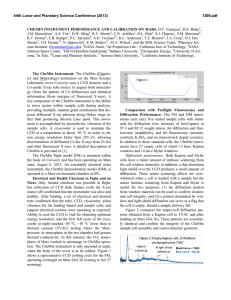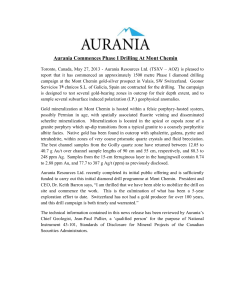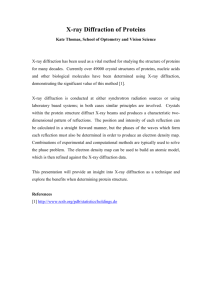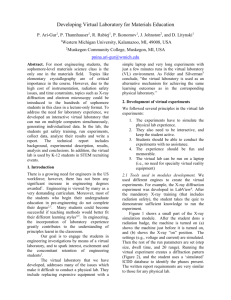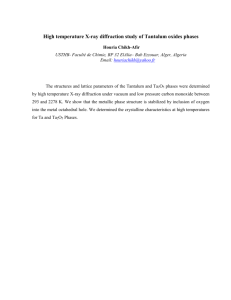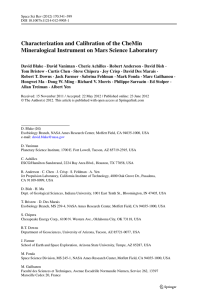THE CHEMIN MINERALOGICAL INSTRUMENT ON THE... MISSION. , D.Vaniman , R. Anderson
advertisement
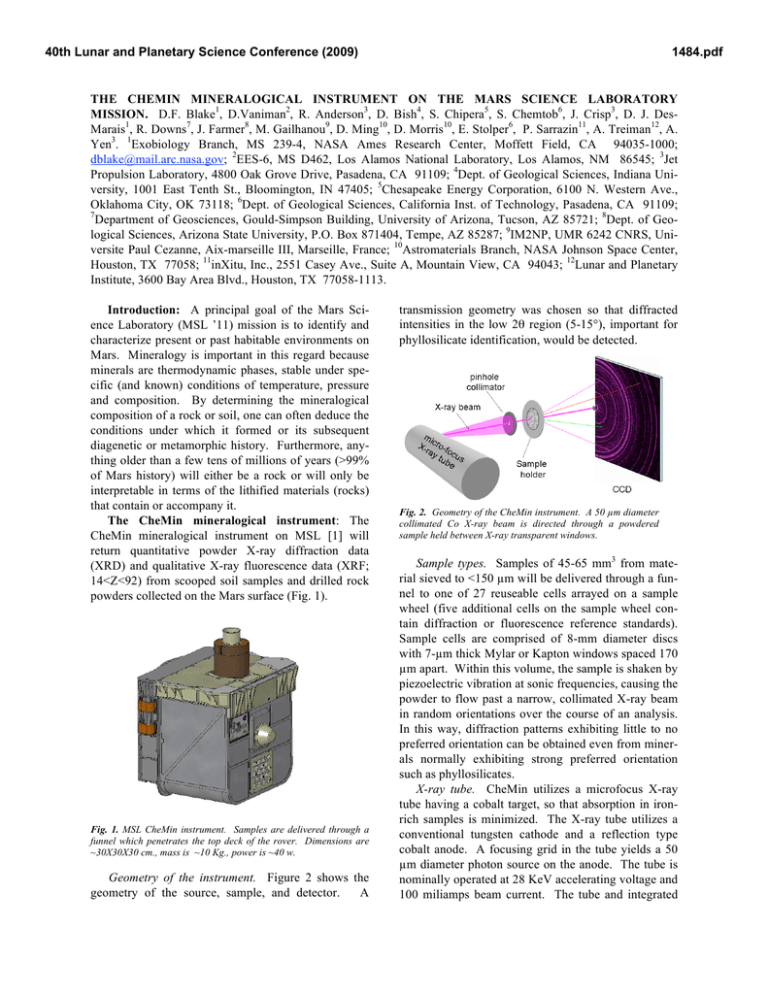
40th Lunar and Planetary Science Conference (2009) 1484.pdf THE CHEMIN MINERALOGICAL INSTRUMENT ON THE MARS SCIENCE LABORATORY MISSION. D.F. Blake1, D.Vaniman2, R. Anderson3, D. Bish4, S. Chipera5, S. Chemtob6, J. Crisp3, D. J. DesMarais1, R. Downs7, J. Farmer8, M. Gailhanou9, D. Ming10, D. Morris10, E. Stolper6, P. Sarrazin11, A. Treiman12, A. Yen3. 1Exobiology Branch, MS 239-4, NASA Ames Research Center, Moffett Field, CA 94035-1000; dblake@mail.arc.nasa.gov; 2EES-6, MS D462, Los Alamos National Laboratory, Los Alamos, NM 86545; 3Jet Propulsion Laboratory, 4800 Oak Grove Drive, Pasadena, CA 91109; 4Dept. of Geological Sciences, Indiana University, 1001 East Tenth St., Bloomington, IN 47405; 5Chesapeake Energy Corporation, 6100 N. Western Ave., Oklahoma City, OK 73118; 6Dept. of Geological Sciences, California Inst. of Technology, Pasadena, CA 91109; 7 Department of Geosciences, Gould-Simpson Building, University of Arizona, Tucson, AZ 85721; 8Dept. of Geological Sciences, Arizona State University, P.O. Box 871404, Tempe, AZ 85287; 9IM2NP, UMR 6242 CNRS, Universite Paul Cezanne, Aix-marseille III, Marseille, France; 10Astromaterials Branch, NASA Johnson Space Center, Houston, TX 77058; 11inXitu, Inc., 2551 Casey Ave., Suite A, Mountain View, CA 94043; 12Lunar and Planetary Institute, 3600 Bay Area Blvd., Houston, TX 77058-1113. Introduction: A principal goal of the Mars Science Laboratory (MSL ’11) mission is to identify and characterize present or past habitable environments on Mars. Mineralogy is important in this regard because minerals are thermodynamic phases, stable under specific (and known) conditions of temperature, pressure and composition. By determining the mineralogical composition of a rock or soil, one can often deduce the conditions under which it formed or its subsequent diagenetic or metamorphic history. Furthermore, anything older than a few tens of millions of years (>99% of Mars history) will either be a rock or will only be interpretable in terms of the lithified materials (rocks) that contain or accompany it. The CheMin mineralogical instrument: The CheMin mineralogical instrument on MSL [1] will return quantitative powder X-ray diffraction data (XRD) and qualitative X-ray fluorescence data (XRF; 14<Z<92) from scooped soil samples and drilled rock powders collected on the Mars surface (Fig. 1). Fig. 1. MSL CheMin instrument. Samples are delivered through a funnel which penetrates the top deck of the rover. Dimensions are ~30X30X30 cm., mass is ~10 Kg., power is ~40 w. Geometry of the instrument. Figure 2 shows the geometry of the source, sample, and detector. A transmission geometry was chosen so that diffracted intensities in the low 2θ region (5-15°), important for phyllosilicate identification, would be detected. Fig. 2. Geometry of the CheMin instrument. A 50 µm diameter collimated Co X-ray beam is directed through a powdered sample held between X-ray transparent windows. Sample types. Samples of 45-65 mm3 from material sieved to <150 µm will be delivered through a funnel to one of 27 reuseable cells arrayed on a sample wheel (five additional cells on the sample wheel contain diffraction or fluorescence reference standards). Sample cells are comprised of 8-mm diameter discs with 7-µm thick Mylar or Kapton windows spaced 170 µm apart. Within this volume, the sample is shaken by piezoelectric vibration at sonic frequencies, causing the powder to flow past a narrow, collimated X-ray beam in random orientations over the course of an analysis. In this way, diffraction patterns exhibiting little to no preferred orientation can be obtained even from minerals normally exhibiting strong preferred orientation such as phyllosilicates. X-ray tube. CheMin utilizes a microfocus X-ray tube having a cobalt target, so that absorption in ironrich samples is minimized. The X-ray tube utilizes a conventional tungsten cathode and a reflection type cobalt anode. A focusing grid in the tube yields a 50 µm diameter photon source on the anode. The tube is nominally operated at 28 KeV accelerating voltage and 100 miliamps beam current. The tube and integrated 40th Lunar and Planetary Science Conference (2009) power supply are contained in a sealed vessel of pressurized SF6. X-ray Detector. The CheMin X-ray detector is an E2V CCD-224 X-ray sensitive 600X600 pixel imager having 40 µm square pixels, a deep depletion zone for high quantum efficiency of 7 KeV X-rays (CoKα) and a thin polygate structure for enhanced sensitivity to lower atomic number elements such as Mg. By exposing, reading and erasing the detector often enough so that in the majority of cases only a single photon is collected in any individual x,y pixel between reads, the position and energy of each photon can be determined (“single photon counting mode”). A 2-D image of all of the 7 KeV X-rays detected by the array over a large number (10’s-100’s) of CCD exposures comprises an energy-filtered CoKα powder diffraction pattern of the sample. A histogram of the energies of all photons detected by the CCD comprises an X-ray Fluorescence spectrum of the sample. Instrument performance. Individual analyses require several hours over one or more Mars sols. For typical well-ordered minerals, CheMin has a Minimum Detection Limit (MDL) of <3% by mass, an accuracy of better than 15% and a precision of better than 10% of the amount present for phases present in concentrations >4X MDL (12%). The resolution of the diffraction patterns is 0.30° 2θ, and the angular measurement range is 4-55° 2θ. This performance is sufficient to allow for the detection and quantification of virtually all minerals. Instrument delivery. The CheMin Flight Model (FM) will be delivered to the MSL project in early January ’09. Performance and calibration data from the CheMin FM will be collected in mid-late January. Terrestrial field-portable versions of CheMin: While no data are yet available from the CheMin FM, a number of field-portable prototype CheMin instruments (CheMin III, IV, Terra and roboTerra) have been developed over the past several years which have the same geometry, 2θ range, 2θ resolution and other performance characteristics as MSL CheMin. These instruments have been evaluated in a variety of Mars analog environments (Antarctica, Death Valley CA, Mauna Kea HI, Rio Tinto Spain, Svalbard Norway, Canadian Arctic). Patterns are of sufficient quality that commercial search-match programs can readily identify the major mineralogy of a sample, and quantitative analysis via Rietveld refinement [2] or full-pattern fitting [3] can be performed with 1-4 hours of data or less, depending on sample complexity. Successful Rietveld refinements have been performed using data collected for only 5-10 minutes using the field deploy- 1484.pdf able Terra instrument, a commercially available version of CheMin [4]. Example of a Clay mineral analysis with CheMin: Discriminating between the variety of possible silicate clay minerals is typically accomplished by taking advantage of the existence of distinct large repeat distances perpendicular to the phyllosilicate layers. As clay mineral discrimination is based primarily on these repeat distances in their structures, it is therefore crucial that a martian XRD instrument be capable of detecting low-angle (large d-spacing) diffraction peaks. Figures 3, 4 and Table 1 show results from CheMin IV obtained from a synthetic mixture of phyllosilicate and evaporite minerals. Fig. 3 (left). 2-D image of diffraction pattern. the ~15Å d-spacing from nontronite (7º 2θ) is seen as the first spatially distinct bright ring of intensity around the undiffracted beam (silouette of beam stop is seen at the center of the lower edge of the image). Fig. 4 (right) shows the conventional 1-D diffractogram that results from summing the 2-D pattern circumferentially around the central undiffracted beam. Table 1 shows a quantitative analysis of this sample using the program FULLPAT [5]. Table 1. Analysis of a known mineral mixture using CheMin IV Phase Nontronite Meas. Known (wt%) (wt%) (Diff., %) Comment 69 61 13.1 Gypsum 22.6 25 -9.6 < 15% < 15% Halite 2.8 8.7 -67.8 <4x MDL Hematite 5.7 5.3 7.5 < 15% With this performance, CheMin can identify and distinguish a number of clay minerals. For example, discrimination between 1:1 phyllosilicates (such as the kaolin minerals), with repeat distances of ~7Å, and smectites (e.g., montmorillonite, nontronite, saponite), with repeat distances from 10-15Å, is straightforward. References: [1] Sarrazin, P. et al., (2005). Powder Diffraction 20, 128-133. [2] Bish, D. and J. Post (1993). Amer. Min. 78, 932– 942 [3] Chipera, S. and D. Bish (2002). J. Applied Crystallography, 35, 744-749. [4] http://www.inxitu.com/index_analytical.html.
